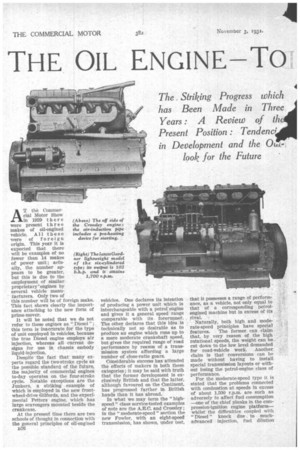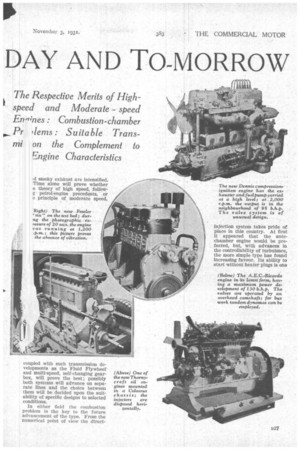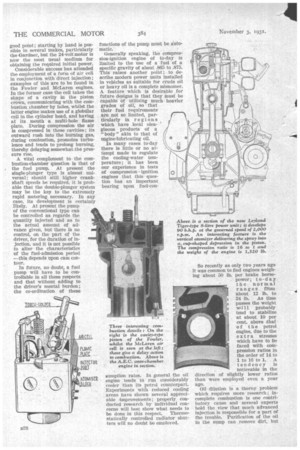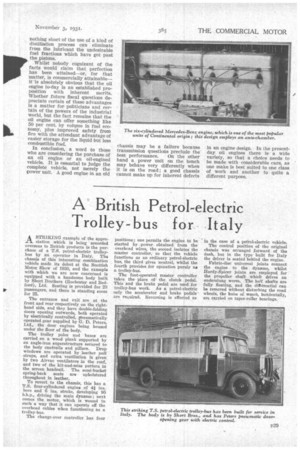THE OIL ENGINE
Page 112

Page 113

Page 114

Page 115

If you've noticed an error in this article please click here to report it so we can fix it.
To
DAY AND TO-MORROW AT the Commercial Motor Show in 1929 there were present three makes of oil-engined vehicle. All the se were of foreign origin. This year it is expected that there will be examples of no fewer than 14 makes of power unit ; actually, the number am pears to be greater, but this is due to the employment of similar proprietary 'engines by several vehicle manufacturers. Only two of this number will be of foreign make. This fact shows clearly the importance attaching to the new form of prime-mover.
It will be noted that we do not refer to these engines as " Diesel " ; this term is inaccurate for the type of unit employed in vehicles, because the true Diesel engine employs air injection, whereas all current designs for use in chassis embody liquid-injection.
Despite the fact that many experts regard the two-stroke cycle as the possible standard of the future, the majority, of commercial engines to-day operates on the four-stroke cycle. Notable exceptions are the Junkers, a striking example of which is employed in the new frontwheel-drive Gilfords, and the experimental Petters engine, which has large scavengers mounted beside the crankcase.
At the present time there are two schools of thought in connection with the general principles of oil-engined
vehicles. One declares its intention of producing a power unit which Is interchangeable with a petrol engine and gives it a general speed range comparable with its forerunner. The other declares that this idea is technically not so desirable as to produce an engine which runs up to a more moderate crankshaft speed, but gives the required range of road performance by reason of a transmission system affording a large number of close-ratio gears.
Considerable success has attended the efforts of makers in both these categories ; it may be said with truth that the former development is exclusively British and that the latter, although favoured on the Continent, has progressed farther in British hands than it has abroad.
In what we may term the " highspeed " class service-tested examples of note are the A.E.C. and Crossley; in the " moderate-speed " section the new Fowler, with an eight-speed transmission, has shown, under test, that it possesses a range of performance, as a vehicle, not only equal to that of a corresponding petrolengined machine but in excess of its rival.
Naturally, both high and moderate-speed principles have special features. The former can claim that, by very reason of the high rotational speeds, the weight can becut down to the low level demanded for road-vehicle work. Another claim is that conversions can be made without having to install special transmission layouts or without losing the petrol-engine class of performance. For the moderate-speed type it is stated that the problems connected with combustion at speeds in excess of about 1,500 r.p.m. are such as adversely to affect fuel consumption —one of the chief planks in the compression-ignition engine platform— whilst the difficulties coupled with " Diesel " knock due to muchadvanced injection, fuel dilution al smoky exhaust are intensified. Time alone will prove whether e theory of high speed, follow; petrol-engine precedents, or e principle of moderate speed, coupled with such transmission developments as the Fluid Flywheel and multi-speed, self-changing gearbox, will prove the best ; possibly both systems will advance on separate lines and the choice between them will be decided upon the suitability of specific designs to selected conditions.
In either field the combustion problem is the key to the future advancement of the type. From the numerical point of view the direct injection system takes pride of place in this country. At first it appeared that the antechamber engine would be preferred, but, with advances in the controllability of turbulence, the more simple type has found increasing favour. Its ability to start without heater plugs is one good point ; starting by hand is possible in several makes, particularly the Crardner, but the 24-volt motor is now the most usual medium for obtaining the required initial power.
Considerable success has attended the employment of a form of air cell in conjunction with direct injection; examples of this are to be found in the Fowler and McLaren engines. In the former case the cell takes the shape of a cavity in the piston crown, communicating with the combustion chamber by holes, whilst the latter engine makes use of a globular cell in the cylinder head, and having at its mouth a multi-hole flame plate. During compression the air is compressed in these cavities; its outward rush into the burning gas, during combustion, promotes turbulence and tends to prolong burning, thereby delaying somewhat the pressure rise.
A vital complement tothe combustion-chamber question is that of the fuel pump. At present the single-plunger type is almost universal; should still higher ersink-shaft speeds be required, it is probable that the double-plunger system may be the key to the extremely rapid metering necessary. In any case, its development is certainly likely. At present the pump of the conventional type can be controlled as regards the quantity injected and as to the actual amount of advance given, but there is no control, on the part of the driver, for the duration of injection, and it is not possible to alter the characteristics of the fuel-admission period —this depends upon cam contour.
In future, no doubt, a fuel pump will have to be controllable in all these respects and that without adding to the driver's mental burden; the co-ordination of these functions of the pump must be automatic.
Generally speaking, the compression-ignition engine of to-day is limited to the use of a fuel of a specific gravity of about .865 to .875. This raises another point; to describe modern power units installed in vehicles as suitable for crude oil or heavy oil is a complete misnomer. A feature which is desirable for future designs is that they Must be capable of utilizing much heavier grades of oil; so that their fuel requirements' are not so limited, particularly in regions which have local oleaginous products of a " body " akin to that of engine-lubricating oil.
In many cases to-day there is little or no attempt made to regulate the cooling-water temperature; it has been our experience in tests of compression ignition engines that this question has an important bearing upon fuel-con sumption rates. In general the oil engine tends tO run considerably cooler than its petrol counterpart. Experiments with reduced cooling areas have shown several appreciable -improvements; properly conducted research by individual concerns will best show what needs to be done in this respect. Thermostatically controlled radiator shutters will no doubt be employed. So recently as only two years ago it was common to find engines weighing about 50 lb. per brake horse power ; to-day the normal ranges from about 12 lb. to 24 lb. As time passes the weight will probably tend to stabilize at about 10 per cent. above ithaf of the petrol engine, due to the extra stresses which have to be faced with compression ratios in the order of 14 to 1 to 16 to 1. A tendency is noticeable in the direction of slightly lower ratios than were employed even a year ago.
Oil dilution is a thorny problem which requires more research ; incomplete combustion is one contributory cause and several experts hold the view that much advanced injection is responsible for a part of the trouble. Purification of the oil in the sump can remove dirt, but nothing short of the use of a kind of distillation process can eliminate from the lubricant the undesirable fuel fractions which have got past
pro the pistons. Whilst nobody cognizant of the facts would claim that perfection has been attained—or, for that matter, is commercially attainable— it is absolutely obvious that the oil engine to-day is an established proposition with inherent merits. Whether future fiscal questions depreciate certain of these advantages is a matter for politicians and certain of the powers of the industrial world, but the fact remains that the oil engine can offer something like 50 per cent. by volume in fuel economy, plus• improved safety from fire with the attendant advantage of easier storage for the liquid but less combustible fuel.
In conclusion, a word to those who are considering the purchase of an oil engine or an oil-engined vehicle. It is essential to judge the complete vehicle, not merely the power unit. A good engine in an old
chassis may be a failure because transmission questions preclude the
best performance. On the other hand a power unit on the bench may behave very differently when it is on the road ; a good chassis cannot make up for inherent defects
in an engine design. In the presentday oil engines there isa wide variety, so that a choice needs to be made with considerable care, as one make is best suited to one class of work and another to quite a different purpose.








































































































































































































































